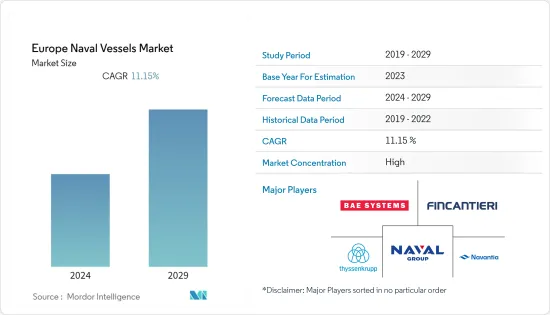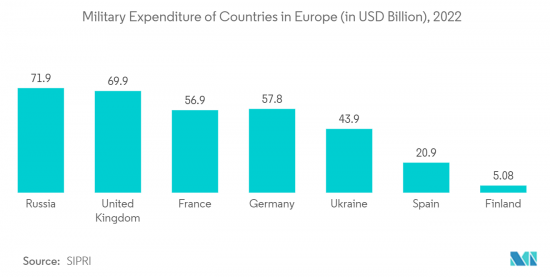PUBLISHER: Mordor Intelligence | PRODUCT CODE: 1406178

PUBLISHER: Mordor Intelligence | PRODUCT CODE: 1406178
Europe Naval Vessels - Market Share Analysis, Industry Trends & Statistics, Growth Forecasts 2024 - 2029

The European naval vessels market was valued at USD 35.43 billion in 2024 and is projected to grow to USD 60.12 billion by 2029, registering a CAGR of 11.15% during the forecast period.
The market is propelled by recent developments of frigates and offshore patrol vessels, owing to their lethality, speed, and maneuverability. The incidents, such as the rise in illegal trespassing of immigrants and drug trafficking in countries such as Italy, Spain, and Albania, have led to the rise in demand for naval vessel developments in this region. Other factors, such as the implementation of the United Nations Convention on the Law of the Sea (UNCLOS) III norms, the need to patrol Exclusive Economic Zones that stretch up to 200 miles beyond national coastlines, and the need for cost-effective naval forces after Cold War era are propelling the market's growth in the region.
The advanced technological developments, such as initiatives to deploy Aegis technology-equipped ships in the European naval fleet and investments in robotics and other digital technology development by local naval shipbuilders, are supporting the growth of the naval vessels market in Europe. However, stringent rules and regulations to reduce emissions and pollution in the ocean are a challenge for naval vessel manufacturers.
Europe Naval Vessels Market Trends
The Frigates Segment is expected to lead the market
Frigates are larger warships compared to corvettes and smaller compared to destroyers. Frigates weigh more than 3,000 tons and have a considerable mix of defense and offensive capabilities. These warships find applications in patrol missions, escorting larger ships to protect sea lines of communication and as an auxiliary component of a strike group. The high lethality and low detection capabilities of the frigates are the major reasons for navies around the world to increasingly procure frigates. This has also resulted in countries increasing their annual defense budget in the procurement of frigates. The replacement programs in various European countries to replace the current aging fleet of combat ships with modern detection and weapon systems equipped with frigates that have anti-ship, anti-submarine, and air-defense capabilities are propelling the demand for frigates. During the forecast period, the majority of frigate procurement is planned in Europe. For instance, in November 2022, the UK Ministry of Defence (MoD) awarded a USD 4.4 billion contract to BAE Systems plc to manufacture the five City Class Type 26 frigates for the Royal Navy in Glasgow. Thus, the frigates segment of the market studied is anticipated to witness steady growth during the forecast period.

United Kingdom to Exhibit Significant Growth During the Forecast Period
The UK is expected to have a notable market share and will exhibit a substantial growth rate, owing to the long coastal line and increased defense procurement. The country has approximately 12,000km of coastal line that needs to be operated. The country experiences border protection issues and crisis management with the increasing number of individuals crossing the English Channel, which has allowed the nation to stay vigilant and keep its naval vessels ready for operations. Due to the increasing causalities in the English Channel, France, and the UK initiated conversations to establish legal migration routes to address the channel crisis. Efforts of the country to modify its existing fleet and increase operational capabilities have led to the UK's procurement of advanced warships. For instance, in December 2021, the Defense Select Committee of the UK announced its plans to increase the number of Royal Navy's frigates and destroyers to more than 19 by 2026 and acquire 20 more frigates and destroyers by 2030. These initiatives were taken post the report published by the UK Defense Committee that the country needs to double the escort fleet and increase the size of attack submarines over the coming years. In August 2022, five Astute-class submarines were commissioned into service, and two were under construction. The entry into service of the last submarine is planned for 2026. Thus, such developments will contribute to the market growth of the UK.
Europe Naval Vessels Industry Overview
The European naval vessels market is consolidated with the presence of prominent players, such as Navantia S.A. SM.E, Naval Group, FINCANTIERI S.p.A., ThyssenKrupp AG, and BAE Systems plc, that are dominating the market. The key players in the market own several shipbuilding yards dedicated to naval vessel developments. The prominent revenue generation strategy of key players is winning contracts and orders from European and foreign governments. The market players are also collaborating to develop advanced naval vessels to cater to the demands of the armed forces. For instance, a consortium led by Fincantieri, Naval Group, and Navantia submitted an industrial proposal to develop a European patrol corvette (EPC) in December 2021. The EPC is expected to replace several classes of ships, from patrol vessels to light frigates, in service of the European countries. Such partnerships are expected to help the players expand their business during the forecast period.
Additional Benefits:
- The market estimate (ME) sheet in Excel format
- 3 months of analyst support
TABLE OF CONTENTS
1 INTRODUCTION
- 1.1 Study Assumptions
- 1.2 Scope of the Study
2 RESEARCH METHODOLOGY
3 EXECUTIVE SUMMARY
4 MARKET DYNAMICS
- 4.1 Market Overview
- 4.2 Market Drivers
- 4.3 Market Restraints
- 4.4 Porter's Five Forces Analysis
- 4.4.1 Bargaining Power of Suppliers
- 4.4.2 Bargaining Power of Buyers/Consumers
- 4.4.3 Threat of New Entrants
- 4.4.4 Threat of Substitute Products
- 4.4.5 Intensity of Competitive Rivalry
5 MARKET SEGMENTATION
- 5.1 Vessel Type
- 5.1.1 Submarine
- 5.1.2 Frigates
- 5.1.3 Corvettes
- 5.1.4 Aircraft Carrier
- 5.1.5 Destroyers
- 5.1.6 Other Vessel Types
- 5.2 Geography
- 5.2.1 Europe
- 5.2.1.1 United Kingdom
- 5.2.1.2 France
- 5.2.1.3 Germany
- 5.2.1.4 Russia
- 5.2.1.5 Spain
- 5.2.1.6 Finland
- 5.2.1.7 Ukraine
- 5.2.1.8 Rest of Europe
- 5.2.1 Europe
6 COMPETITIVE LANDSCAPE
- 6.1 Company Profiles
- 6.1.1 A&P Group Limited
- 6.1.2 FINCANTIERI S.p.A.
- 6.1.3 Naval Group
- 6.1.4 Fr. Lurssen Werft GmbH & Co. KG
- 6.1.5 German Naval Yards Kiel GmbH
- 6.1.6 Dassault Systemes
- 6.1.7 BAE Systems plc
- 6.1.8 ThyssenKrupp AG
- 6.1.9 Navantia S.A. SM.E
- 6.1.10 JSC United Shipbuilding Corporation
- 6.1.11 Rauma Marine Constructions
- 6.1.12 Smart Maritime Group
7 MARKET OPPORTUNITIES AND FUTURE TRENDS




